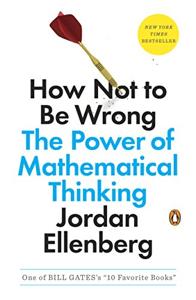
Want to learn the ideas in How Not to Be Wrong better than ever? Read the world’s #1 book summary of How Not to Be Wrong by Jordan Ellenberg here.
Read a brief 1-Page Summary or watch video summaries curated by our expert team. Note: this book guide is not affiliated with or endorsed by the publisher or author, and we always encourage you to purchase and read the full book.
Video Summaries of How Not to Be Wrong
We’ve scoured the Internet for the very best videos on How Not to Be Wrong, from high-quality videos summaries to interviews or commentary by Jordan Ellenberg.
1-Page Summary of How Not to Be Wrong
Overview
Statistics is a critical tool for making decisions. It’s also something that everyone needs to understand and use in their everyday lives. However, statistics can be misleading if not analyzed correctly. In Naked Statistics, author Charles Wheelan explains how to critically evaluate data, avoid common mistakes when using it, and apply basic math principles to real-life situations.
Mathematics is really the science of common sense. It’s a reflection of things we already know intuitively. Mathematicians speak in a specialized language so that they can convey complex ideas quickly and precisely, but it doesn’t make mathematics complicated or beyond comprehension. The mental work involved in solving complex mathematical problems isn’t that different from the thinking we do in many common situations, such as figuring out where to park your car at the mall or how much change you should get back when paying for gas. In this article, you’ll learn how to uncover the “hidden math” in your life and use it to solve everyday problems and not be wrong about them anymore.
Here are some key points:
Many research findings published in journals are incorrect.
A debut novelist’s second book is usually worse than his or her first bestseller.
There is no such thing as public opinion; everyone has their own opinions, and they’re all different from each other.
Big Idea #1: Math is the study of avoiding errors. It’s based on common sense.
When you were in school, the math problems might have been too complicated for you. You might have wondered whether or not you would ever use them in real life.
Yes, math is relevant. We all use it every day. It’s a science that helps us solve common problems and not be wrong about our decisions.
Let’s consider the example of a plane that has been shot at in World War II. The fuselage is always more damaged than the engine, even though it should be protected by armor. Therefore, military advisors suggested to improve the armor for the fuselage and not for the engine. However, a young mathematician suggested giving better protection to the engine instead of improving armor on fuselages.
The author wanted to find out why more planes didn’t make it back when they took shots to the engine. He hypothesized that those planes were ones where the engines weren’t reinforced with better armor, and that if they had been, more planes would have made it back.
There is a logical error called survivorship bias that’s affecting the advice given to airline companies. The advisors are looking at the survivors of plane crashes, but not looking at all of the planes that didn’t survive. This problem can be solved through math and common sense. For example, if you have five stones and add seven more stones, it doesn’t matter which order you do it in; they’ll still total 12 stones.
Mathematics is derived from our intuition. For example, even though we can’t solve entire equations with our intuition, mathematics reflects it by defining addition as commutative: for any choice of a and b, a + b = b + a.
Big Idea #2: When you simplify problems, you can solve them more easily.
A basic rule of mathematics is to solve the problem that’s easier for you. If you have a difficult problem, try solving a simpler version of it and hope that the solution is close enough to your original problem.
We can simplify problems by assuming that they are linear. This is done in geometry when we consider straight lines as the solution to a problem, rather than curves or other nonlinear methods.
Imagine an ant walking around a big circle. From the ant’s perspective, it would feel like it was walking in a straight line. In fact, if we zoomed in closely enough on a part of the circle’s curve, it would look like a straight line to us as well. This is similar to many straight lines bent at very slight angles looking like curves from far away. Suppose you want to measure the area of that circle using only straight lines? You can do this by inserting polygons with more sides and corners into each remaining space until the areas are nearly equal.





